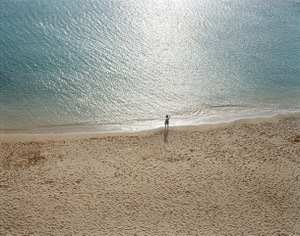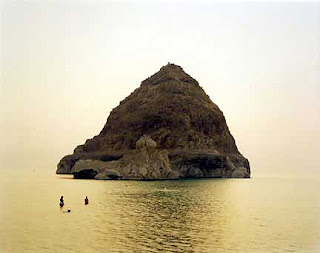'Wanderer in the mists' (1818) Caspar David Friedrich
'Untitled #2" (2002) Richard Misrach
'Untitled # 394-03' (2003) Richard
The Enlightenment was the creation of a new framework of ideas about man, society, and nature, which challenged existing conceptions rooted in a traditional world-view, dominated by Christianity (Hamilton, 1992). It started around about the 17th century and many argue it is still continuing today. It was a time where reason and rational thinking were introduced to understand the world through empiricism and human experience (Hooker, 1996).
2. Define the concept of the Sublime.
“The sublime” was defined in 1756 by the British statesman and political theorist Edmund Burke (1729-1797). The basis of Burke’s beliefs was that the life of feeling and spirit depended on a harmony within the larger order of the universe. The sublime therefore was the ultimate experience of divinity, a mixture of awe, fear and enlightenment produced by the contemplation of a powerful, terrifying nature (ALVC Resource Book, 2011). The elements of nature and divinity being god creating all in nature perfectly and beautifully are interlinked to landscape in which the sublime is often seen and portrayed in art.
3. How did the concept of the Sublime come out of the Enlightenment thought?
Within the time period of enlightenment thought, the ideas of empiricism and secularism arose. This meant that the natural world around people was studied and experienced, much of this being nature and landscapes. The association between the power of nature and a recognition of the divinity behind it was a constant theme in early Romantic writing (ALVC Resource Book, 2011). The writer Wilhelm Wackenroder proclaimed that there exist only two languages through which God allows humans to comprehend the Divine; one of these is reserved for God alone... the second language having two components: “they are: nature and art” (ALVC Resource Book, 2011). From these ideas artists began focusing on landscapes as art themselves instead of picturesque backgrounds for other subject matter. They started filling the scenes with symbolic meanings of religious beliefs. Often in sublime art, figures are solitary and anonymous showing they could be anybody and their insignificance in the functioning of the world as a whole. They represent how the world goes on and functions without them and that ultimately they are small and overpowered by the divinity of nature. Sublime art often entices the viewer to take a place within the artwork and experience the sublime.
4. Discuss the subject matter and aesthetic (look) of Misrach's work to identify the Sublime in his work. Add some more images of his work.
Misrach’s works are photographs of human intervention in natural landscapes. They show small figures in huge majestic powerful settings that seem every bit as vulnerable as the world that they occupy (Ayers, 2008). He "paint[s] an elegant picture of the strangeness and upset balance of human activity in an alien landscpae" (Richard Misrach," 2005-2011). He takes photographs of desserts and oceans as they are “ultimate definition of the sublime because we’re in awe of it—its glory and its beauty—but it’s still really scary and dangerous” (Ayers, 2008). He started doing his works in this way when he “was drawn to the fragility and grace of the human figure in the landscape” (Risch, 2010). He was strongly influenced by the images that came out of the 9/11 World Trade Tower plane bombings and the fragility of the people involved and their powerlessness to stop it. He was also inwas also influenced by the1950s Cold War novel and film, On the Beach (Risch, 2010). They are sublime in their showing divinity through nature being landscapes and the smallness of one or more human beings in the scale of the world and the universe.
Swimmers, Pyrammid Lake Indiana Reservation, Nevada, 1987-93
White Man Contemplating pyramids, Eygpt, 1989-1991
5. Identify some other artists or designers that work with ideas around the Sublime, from the Enlightenment era as well as contemporary artists.
Painting of St. Peter's Square in 1630 by Viviano Codazzi.
The huge scale of the building surrounded by tiny figures is reminiscent of the ideas of the sublime in art showing the awe and power of the building over human life.
Bridge near The Usk, by J.M.W. Turner (1775-1851). Watercolour. England, 19th century.
J.M.W. Turner’s work shows the natural landscape that is symbolic of divinity on earth as was the idea of the sublime. I like this painting a lot and think that it does make you feel in awe of the landscape around you and the impressive scale of it all.
Luc Tuymans, The Walk 1993, Oil on canvas, 37x48cm
This work reminds me of Caspar David Friedrich 'Wanderer in the mists' showing the backs and mainly silhouette of the men looking out onto a vast distant landscape. Though the figures are large and obvious in the painting the power of the natural setting is greater than them, making them seem weak and fragile in balance to the landscape.
Pierre Huyghe, Still from One Million Kingdoms 2001, Video installation with sound, 7mins
I like this image from a video installation by Pierre Huyghe for its influence of the sublime but difference from it. The green tall digital projections appear like mountains and tower over the figure as they would in nature but having been digitally made create an interesting twist on the idea of the sublime in art.
6. How does Misrach's photography make you feel? Does it appeal to your imagination?
To me Misrach’s works make humans appear small in the scale of the world and insignificant. They are small dots in the entirety that is the universe and even the world. Individually they are alone and powerless against nature but together and in groups can overtake it and occupy/consume the world around them. it appeals to me in the way it portrays the world and nature as vast and open, as if the world is itself infinite with places that seem almost untouched by human hand such as 'Untitled # 394-03' (2003) as well as places completely dominated by human hand such as White Man Contemplating Pyramids in which the pyramids are manmade into the landscape.
7. Add a Sublime image of your choice to your blog, which can be Art or just a Sublime photograph.
Caspar Friedrich "Monk by the Sea" 1809
Katy Dick, “5:20”, 1.1.2011
Hamilton, P. (1992). The Enlightenment nad the birth of social science, in Hall, S. & Gieben B. (eds.), Formations of Modernity. Cambridge: Open University Press (pg.23)
Hooker, R. (1996). The scientific revolution. Retrieved 21 February, 2006 from: http://www.wsu.edu:800/~dee/ENLIGHT/SCEREV.HTM
AUT University. (2011). ALVC1 Resource Book. Pg 109. The Tradition Invented: The Theory of the Sublime. Retrieved Decmeber 11, 2002 from http://media.dickinson.edu/landscapes/Ia_landscape_Europe.html
Richard Misrach(Copyright 2005–2011 Museum of Contemporary Photography) http://www.mocp.org/collections/permanent/misrach_richard.php
Risch, C. (2010, January 28). Visions of the Decade: Richard Misrach’s On The Beach (5 Photos) http://www.pdnphotooftheday.com/2010/01/3367











I love how you included the quote “ultimate definition of the Sublime because we’re in awe of it – its glory and its beauty,” to define the oceans and desserts captured in Misrach’s photographs in question fours discussion. I love this quote because I have the same subliminal thoughts when I look out into the ocean, which seems to disappear into the horizon. I believe the vastness of the ocean truly captures the concept of the sublime.
ReplyDeleteI am impressed with the research you did to find the works relating to the sublime like you did. I particularly like the last image, in which features the sunset which you even took yourself- (only just read that part)! I think that you have done really well with this entry.
ReplyDeleteI agree with Gemma and you Katy about how the ocean is so big it really does show the concept of sublime in so many ways, because of the terrifying things it can do beyond our power which richard captures in his photographs of the landscapes. It also shows in his images sublimity in the way that he captures the colour and the light of the water and the sky. you are correct about richard about how his images reflect and influenced him to give himself a kind of therapy of the 9/11 bombings and everyones powerlessness they felt in being unable to stop what was going on and what they were seeing. His images of the beach which i thought was interesting and can totally see the influence was the cold war novel and film in the 1950s when i read that it made me think of war movies i have seen of battles on the beach and how people were laying dead like they look like in some of his beach images eg/ the man laying in the whole in the beach you can see the stillness in that photo as if he has been shot or jumped off something. you have done some really good indepth research and i really like the way you have referenced everything so well and properly!!
ReplyDeleteAfter reading you blog about landscape and the sublime, I can understand better about them. Most definitions are from our ALVC resource book. It’s a good way to read it before we start write the blog. I like Misrach's photography about desserts and oceans, because I can feel human beings are too small to compare those huge natural landscape.I love the ultimate definition he chosen, it’s glory and beautiful. And it is also interesting to know he was influenced by the war and 9/11 tower plane bombing. Caspar Friedrich "Monk by the Sea" 1809 is a good example art work for sublime. The grey and dark colours turn on the charm.
ReplyDeleteI can tell a lot of research and effort has gone into this blog and the questions have all been answered real thoroughly. But I thought that the blog would be easier to read if you had a sentence at the end of each question summing up your answer. It was kind of difficult to understand the answer to some of the questions such as question 3. The response to the question seemed somewhat cluttered. But I particularly liked your response to question 6. It was pretty insightful and I could agree with most of it.
ReplyDeleteMisrach's photos show how the vast scale of the ocean compares to us as humans.He alsoconcentrates upon the beauty of nature with abundance of space.It basically depicts our size as humans
ReplyDeleteI like it with the research you did to find the works relating to the sublime like you explain. Also I like how you put the quote “ultimate definition of the Sublime because we’re in awe of it – its glory and its beauty,” it was same feeling, when I saw huge ocean views:) I seem u had a lot of research and found out great example of the sublime. I strongly agree with this example; Pierre Huyghe for its influence of the sublime but difference from it. The green tall digital projections appear like mountains and tower over the figure as they would in nature but having been digitally made create an interesting twist on the idea of the sublime in art.
ReplyDelete